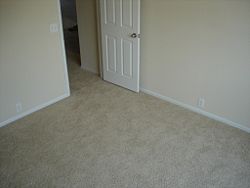
Baseboard
Encyclopedia

Architecture
Architecture is both the process and product of planning, designing and construction. Architectural works, in the material form of buildings, are often perceived as cultural and political symbols and as works of art...
, a baseboard (also called skirting board, skirting, mopboard, floor molding, as well as base molding) is a (generally wooden) board
Lumber
Lumber or timber is wood in any of its stages from felling through readiness for use as structural material for construction, or wood pulp for paper production....
covering the lowest part of an interior wall
Wall
A wall is a usually solid structure that defines and sometimes protects an area. Most commonly, a wall delineates a building and supports its superstructure, separates space in buildings into rooms, or protects or delineates a space in the open air...
. Its purpose is to cover the joint between the wall surface (usually plaster
Plaster
Plaster is a building material used for coating walls and ceilings. Plaster starts as a dry powder similar to mortar or cement and like those materials it is mixed with water to form a paste which liberates heat and then hardens. Unlike mortar and cement, plaster remains quite soft after setting,...
or drywall
Drywall
Drywall, also known as plasterboard, wallboard or gypsum board is a panel made of gypsum plaster pressed between two thick sheets of paper...
) and the floor.
It covers the uneven edge of flooring next to the wall; protects the wall from kick
Kick
In combat sports and hand-to-hand combat, a kick is a physical strike using the foot, leg, or knee . This type of attack is used frequently, especially in stand-up fighting...
s, abrasion
Abrasion (mechanical)
Abrasion is the process of scuffing, scratching, wearing down, marring, or rubbing away. It can be intentionally imposed in a controlled process using an abrasive...
, and furniture; and can serve as a decorative molding.
At its simplest, baseboard consists of a simple plank nail
Nail (engineering)
In woodworking and construction, a nail is a pin-shaped, sharp object of hard metal or alloy used as a fastener. Formerly wrought iron, today's nails are typically made of steel, often dipped or coated to prevent corrosion in harsh conditions or improve adhesion...
ed, screw
Screw
A screw, or bolt, is a type of fastener characterized by a helical ridge, known as an external thread or just thread, wrapped around a cylinder. Some screw threads are designed to mate with a complementary thread, known as an internal thread, often in the form of a nut or an object that has the...
ed or glued
Adhesive
An adhesive, or glue, is a mixture in a liquid or semi-liquid state that adheres or bonds items together. Adhesives may come from either natural or synthetic sources. The types of materials that can be bonded are vast but they are especially useful for bonding thin materials...
to the wall; however, particularly in older houses, it can be made up of a number of mouldings for decoration.
Plastic baseboard is usually available in white or a flexible version in several colors and is generally glued to the wall. Wooden baseboard is available in paint or stain grade versions. Paint grade will not take stain well. Paint grade baseboards can be either "raw finger jointed" or "primed." Stain grade woods—such as oak, pine, and maple—are clearer and are suitable for staining in natural finishes.
Radiators are sometimes installed inside or in front of baseboards (baseboard radiators).
A baseboard differs from a wainscot
Wainscot
Wainscot is a term used in fantasy fiction to describe societies that are concealed and secretly working in the real world. It was first coined by The Encyclopedia of Fantasy in 1997....
; a wainscot typically covers from the floor to around 1-1.5m high (waist or chest height), whereas a baseboard is typically only 0.2m high (ankle height).

